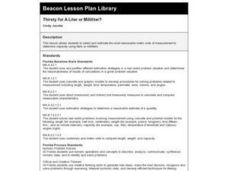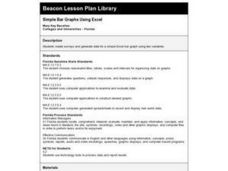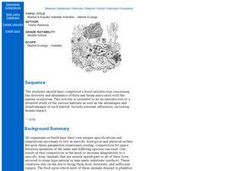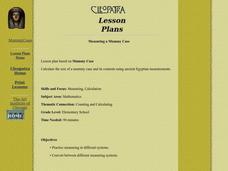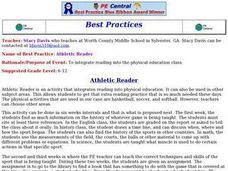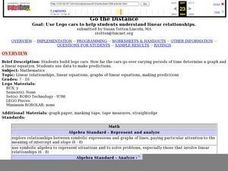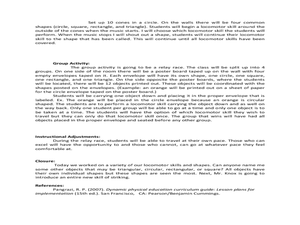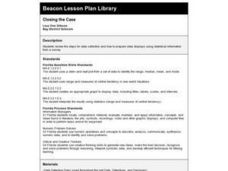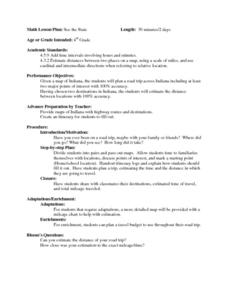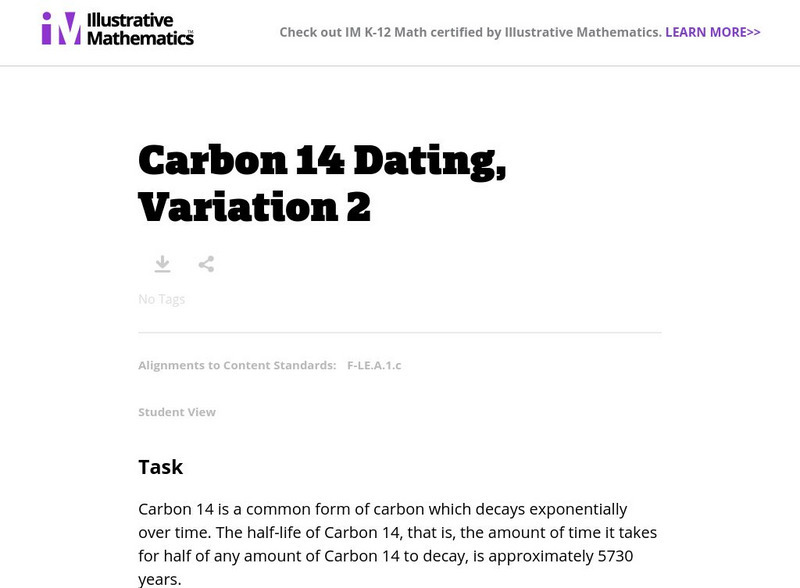Curated OER
Thirsty for A Liter or Milliliter?
Second graders work with liters and milliliters for measurement.
Curated OER
Simple Bar Graphs Using Excel
Students create original survey questions, and develop a bar graph of the data on paper. They input the survey data using two variables onto an Excel bar graph spreadsheet.
Curated OER
Marine & Aquatic Habitats Activities - Marine Ecology
Students enact the life cycle of a sessile animal and quantify the possibility of survival under the conditions given. They then present to the class a new adaptation which will increase the animals chance of survival.
Curated OER
Measuring a Mummy Case
Students calculate the size of a mummy case and its contents using ancient Egyptian measurements.
Curated OER
Geo Jammin' - Day 5, Lesson 16: Capturing "Lions" of Poetry
Second graders participate in the Author's Chair, which is placed in the front of the room. The puppet, Geo George, asks students to take out their poems, then brings them to the Author's Chair individually to share their poems with the...
Curated OER
Shadow Trackers: From Photography to Writing
Students explore the rotation of the earth. In this science lesson, students view photos of various places around the world. Students conduct an experiment in which they can see how the earth's rotation creates shadows on the earth.
Curated OER
Athletic Reader
Pupils research the history of the sport they are participating in. They conduct research and write a report, create a timeline of the sport, and investigate the history of the sport in other countries. Students then observe and...
Curated OER
Go the Distance
Students work together to build lego cars. They make predictions about how fast they believe the cars will go. They record their observations and discuss their results.
Curated OER
Shapes and Review of Locomotor Skills
Students engage in a series of loco-motor activities based on shapes. In this loco-motor lesson plan, students demonstrate physical skills through races, jumping, hopping, galloping in circles, squares, rectangles and triangles.
Curated OER
Money Skills (Using Coins)
Students pretend to purchase items at their class store using coins. At the store, they are to state the amount of the item they want to buy by reading the label. They give the cashier the correct amount of coins and are given a mark on...
Curated OER
Field Exercise: Stream Flow Dynamics & Sedimentation
Young scholars produce a vertical profile of a stream and map and define thalweg, point bar, and cut bank. They measure flow velocity differences across a stream transect and equate flow velocity with size of substrate sediment collected.
Curated OER
Closing the Case
Fifth graders collect data and prepare data displays using a survey with statistical information.
Curated OER
See the State
Fourth graders are given a map of Indiana and have to plan a road trip including at least two major points of interest with 100% accuracy. The students estimate the distance between their two chosen locations with 100% accuracy.
Curated OER
Text as Texture Collage
Students explore the concepts of rhythm, movement, contrast and texture. They practice using new vocabulary and work on creating a college after designing the arrangement. They self-evaluate their collage and critique their classmates...
Scholastic
Scholastic: Max's Math Adventures: The Snowball
Join Max and Ruthie on a snow day math adventure and see how many things can happen in just one day. Teachers will like this lesson's approach to experiencing and telling time. Use the teacher's guide, activity sheet, and extra...
Other
Nearpod: Elapsed Time
In this lesson on elapsed time, 3rd graders will explore real-world situations while learning to calculate elapsed time using different methods and modeling.
Better Lesson
Better Lesson: It Is About Time
Second graders worked on telling time to the hour and half hour earlier in the year. Now they will apply their understanding of counting by 5s to telling time to the five minute interval.
Illustrative Mathematics
Illustrative Mathematics: F Le Carbon 14 Dating, Variation 2
In this task on exponential decay, students calculate what the amount of Carbon 14 left in a preserved plant will be as time passes and when one microgram will be all that is left. Aligns with F-LE.A.1.c.


